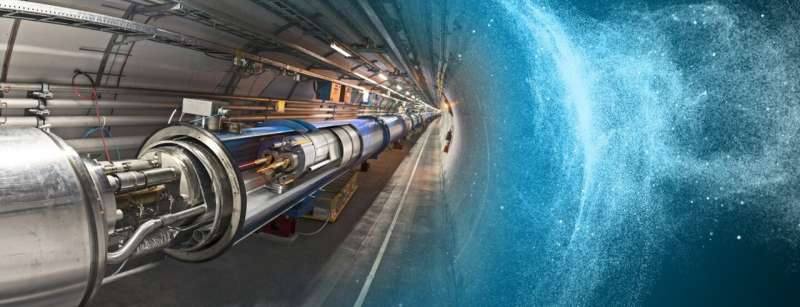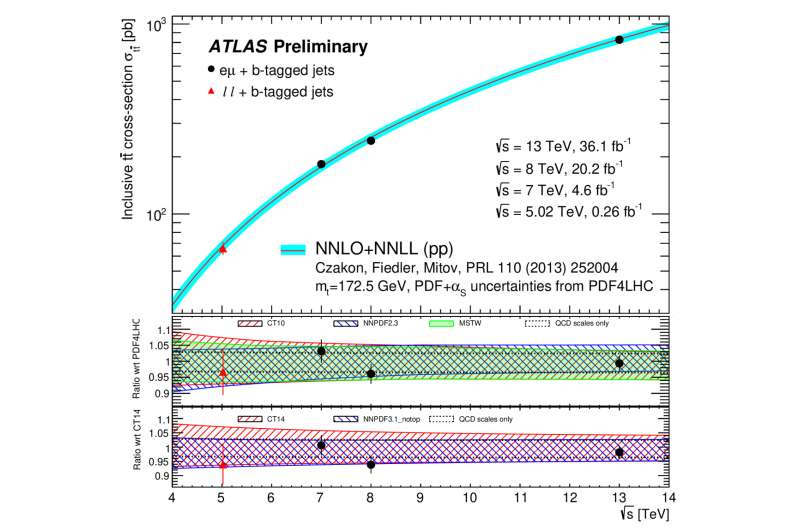#Studying top quarks at high and not-so-high energies

“#Studying top quarks at high and not-so-high energies”

CERN’s Large Hadron Collider (LHC) is famous for colliding protons at world-record energies—but sometimes it pays to dial down the energy and see what happens under less extreme conditions. The LHC started operation in 2010 with a collision energy of 7 TeV, and ran at 13 TeV from 2015 to 2018. But for one week in 2017, the LHC produced moderate-intensity collisions at only 5 TeV—allowing scientists to analyze the production of various elementary particles at a lower collision energy.
One particle they were especially keen to study was the top quark. As the heaviest-known elementary particle, the rate (or cross-section) for producing top-quark pairs depends very strongly on the collision energy achieved. By measuring the production rate at different energies, scientists can learn more about the distributions of the quarks and gluons that make up the proton.
The ATLAS Collaboration at CERN has released a new measurement of the top-quark pair-production rate in the 5 TeV data sample. With just a single week of data, their final measurement has an uncertainty of just 7.5%. This uncertainty is primarily due to the very small size of the 5 TeV data sample, with systematic uncertainties related to the calibration of the LHC luminosity and the experimental response being only a few percent.
Top quarks decay rapidly and leave a distinct signature in the detector. To spot top-pair collision events, ATLAS physicists looked for events with two electrons, two muons, or an electron–muon pair, one or two ‘b-tagged’ jets of particles (coming from b-quark decays), and a significant momentum imbalance indicating the presence of a neutrino. This selection heavily suppresses background events from the production of other types of particles, particularly in the case of electron–muon events. In events with either two electrons or two muons, there is still a large background from events with Z bosons to contend with. Physicists reduced this background using the measured energies and angles of the electrons and muons, requiring their combination to be inconsistent with originating from a Z boson decay.

The new measurement is shown in the plot featured in this article (the red triangle). Previous measurements at higher energies from electron–muon events alone are also included. The cross-section at 5 TeV is more than a factor ten smaller than that at the highest energy of 13 TeV. All the measurements are in excellent agreement with theoretical predictions, which combine the theory of quantum chromodynamics with knowledge of the internal structure of the proton.
Such comparisons serve to validate the understanding of proton–proton collisions, and act as a springboard to the next LHC run starting in 2022, where CERN hopes to further increase the LHC collision energy towards 14 TeV.
Zooming in on top-quark production
Measurement of the tt production cross-section using dilepton events in proton–proton collisions at 5.02 TeV with the ATLAS detector (ATLAS-CONF-2021-003): atlas.web.cern.ch/Atlas/GROUPS … ATLAS-CONF-2021-003/
Citation:
Studying top quarks at high and not-so-high energies (2021, April 30)
retrieved 1 May 2021
from https://phys.org/news/2021-04-quarks-high-not-so-high-energies.html
This document is subject to copyright. Apart from any fair dealing for the purpose of private study or research, no
part may be reproduced without the written permission. The content is provided for information purposes only.
If you liked the article, do not forget to share it with your friends. Follow us on Google News too, click on the star and choose us from your favorites.
For forums sites go to Forum.BuradaBiliyorum.Com
If you want to read more Like this articles, you can visit our Science category.



